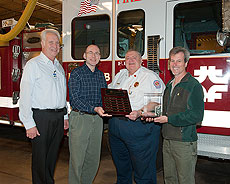Larry Meyer wins 2009 Industrial Hygiene Award
 |
|
Fermilab Fire Department Battalion Chief Larry Meyer (center right) receives the 2009 Industrial Hygiene award from Fermilab Fire Chief Jack Steinhoff, ES&H's Dave Baird and BSS head Dave Carlson.
Credit: Reidar Hahn |
Larry Meyer was trained to save lives, but Fermilab's Fire Department Battalion Chief didn't expect to do it through an extensive research project.
Meyer recently received the laboratory's 2009 Industrial Hygiene Award for his efforts in researching and recommending a new toxic-air testing instrument to replace a nearly outdated model that was becoming difficult to maintain.
"It is nice to be recognized for doing a good job, but I never expected an award," said Meyer, who has worked at the laboratory for 32 years. "I was just doing my job."
The award is given annually to an employee or a group whose efforts and support have done the most to develop and further Fermilab's industrial hygiene program.
"Chief Meyer really got the ball rolling for the rest of the individuals who use this equipment," said Greg Mitchell, the Industrial Hygiene representative from Business Services Section, who delivered the award.
Firefighters and other laboratory individuals use air monitors prior to entering confined spaces: areas such as utility manholes and pump vaults. The devices measure air contaminants, such as carbon monoxide and flammable gases, and oxygen levels to assure that the work area is safe.
But Fermilab's air monitors must also work in a helium environment. When Meyer learned last year that the manufacturers of the laboratory's air monitors would no longer offer support, he knew Fermilab had to find a new product, a challenge since helium environments are rare.
He spent six months contacting manufacturing companies and their technical support teams. He and the rest of the Fire Department field tested the equipment and reviewed the site-specific equipment training program.
He eventually found a separate oxygen monitor that works in a helium environment. It will be used in conjunction with regular air monitors.
"This was a big effort," Meyer said. "Air monitors are the items that we probably use the most. We use them every day."
Meyer received the award on Nov. 17. A plaque that bears his name, and the names of previous recipients, now hangs in the Fire Station.
-- Rhianna Wisniewski
|